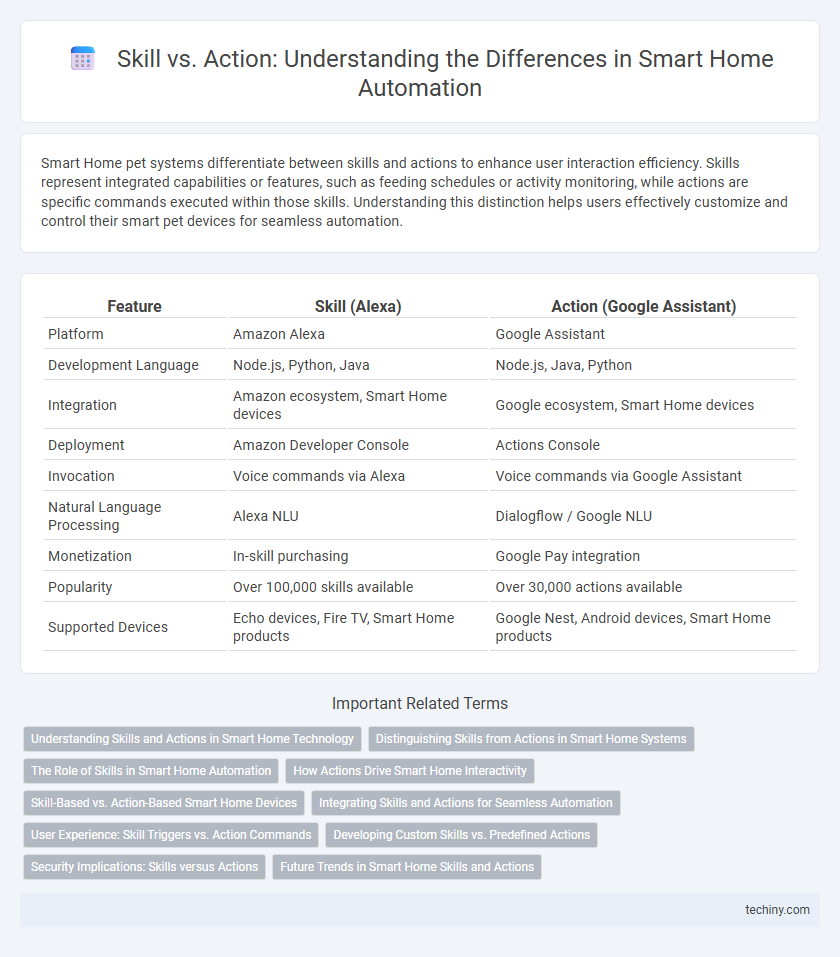Smart Home pet systems differentiate between skills and actions to enhance user interaction efficiency. Skills represent integrated capabilities or features, such as feeding schedules or activity monitoring, while actions are specific commands executed within those skills. Understanding this distinction helps users effectively customize and control their smart pet devices for seamless automation.
Table of Comparison
| Feature | Skill (Alexa) | Action (Google Assistant) |
|---|---|---|
| Platform | Amazon Alexa | Google Assistant |
| Development Language | Node.js, Python, Java | Node.js, Java, Python |
| Integration | Amazon ecosystem, Smart Home devices | Google ecosystem, Smart Home devices |
| Deployment | Amazon Developer Console | Actions Console |
| Invocation | Voice commands via Alexa | Voice commands via Google Assistant |
| Natural Language Processing | Alexa NLU | Dialogflow / Google NLU |
| Monetization | In-skill purchasing | Google Pay integration |
| Popularity | Over 100,000 skills available | Over 30,000 actions available |
| Supported Devices | Echo devices, Fire TV, Smart Home products | Google Nest, Android devices, Smart Home products |
Understanding Skills and Actions in Smart Home Technology
Skills and Actions represent core components in smart home technology, enabling devices to interpret and execute user commands effectively. Skills, commonly used in platforms like Amazon Alexa, are voice-driven capabilities developed to extend device functions, while Actions pertain to Google Assistant's equivalent integration framework designed to control and automate smart home devices. Understanding these distinct frameworks allows for seamless interaction, optimized device control, and enhanced user experiences within connected home environments.
Distinguishing Skills from Actions in Smart Home Systems
Skills in smart home systems refer to predefined capabilities or functionalities that enable devices to perform specific tasks, while actions are the actual commands or operations executed by these skills in real time. Skills act as the interface layer that interprets user intents and translates them into executable actions such as turning on lights or adjusting thermostats. Understanding the distinction between skills and actions improves system integration, allowing for more efficient automation and user interaction within smart home environments.
The Role of Skills in Smart Home Automation
Skills enable smart home devices to perform specific functions by processing voice commands and integrating with various services, enhancing automation capabilities. Actions refer to the tasks executed by these skills, such as turning on lights or adjusting thermostats, which streamline user interaction with home systems. The development of advanced skills expands the range of automated processes, improving convenience, energy efficiency, and security in smart homes.
How Actions Drive Smart Home Interactivity
Actions in smart home systems represent specific tasks or commands executed by connected devices, enabling seamless interactivity and personalized automation. These actions are the operational components triggered by user requests or scheduled routines, allowing devices like lights, thermostats, and security systems to respond intelligently. By translating user intents into concrete device behaviors, actions drive the dynamic and responsive nature of smart home environments.
Skill-Based vs. Action-Based Smart Home Devices
Skill-based smart home devices rely on pre-programmed capabilities or "skills" such as voice commands and routines, enabling users to customize interactions and automate tasks through platforms like Amazon Alexa or Google Assistant. Action-based devices, on the other hand, perform specific functions autonomously, responding directly to sensor inputs or environmental changes without requiring explicit user commands. The choice between skill-based and action-based devices influences home automation efficiency, user control, and integration flexibility within a smart home ecosystem.
Integrating Skills and Actions for Seamless Automation
Integrating Skills and Actions in smart home systems enables seamless automation by allowing devices to execute complex commands through voice or app-based interfaces. Skills, often provided by third-party developers, expand the capabilities of virtual assistants, while Actions represent the specific tasks these assistants perform on smart devices. Harmonizing Skills and Actions enhances interoperability, creating a cohesive user experience that streamlines control over lighting, security, climate, and entertainment systems.
User Experience: Skill Triggers vs. Action Commands
Skill triggers in smart home systems offer predefined phrases that enhance seamless user interaction by recognizing specific verbal cues, while action commands deliver direct instructions for immediate device control. Users benefit from skill triggers through intuitive engagement with complex functionalities, whereas action commands prioritize speed and precision in executing tasks. Integrating both approaches optimizes overall user experience by balancing ease of use with efficient control.
Developing Custom Skills vs. Predefined Actions
Developing custom skills offers tailored functionality that precisely meets unique user needs, enabling deeper integration with specific devices and services within a smart home ecosystem. Predefined actions provide convenience through ready-to-use commands but limit customization and adaptability in complex automation scenarios. Leveraging custom skills enhances personalization and control, making smart home interactions more efficient and responsive.
Security Implications: Skills versus Actions
Skills and Actions in smart home systems differ significantly in security implications, where Skills often require extensive user permissions and data access, increasing potential vulnerabilities. Actions typically operate within confined parameters, minimizing exposure to sensitive information and reducing risks of unauthorized control. Evaluating security protocols for both is essential to safeguard smart home environments from cyber threats.
Future Trends in Smart Home Skills and Actions
Smart Home Skills and Actions are rapidly evolving with advancements in AI and IoT integration, enabling more intuitive voice control and personalized automation. Emerging trends indicate increased interoperability across devices and platforms, fostering seamless user experiences and enhanced security protocols. Predictive analytics and adaptive learning will further optimize smart home environments, transforming how users interact with their connected spaces.
Skill vs Action Infographic

 techiny.com
techiny.com